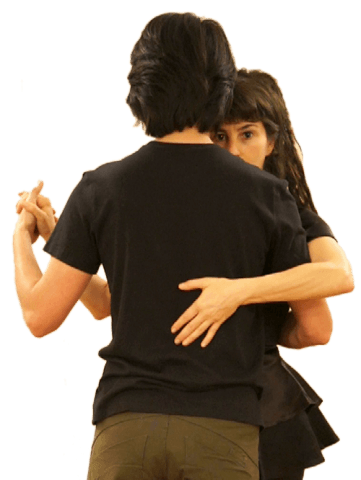As you know, I’m wary of tango truisms. And both the Guardia Nueva (that’s my tongue-in-cheek phrase for the youthful old guard) and the Tango Left (neo-queer-one…) have their truisms.
One of the truisms of the Tango Left is that tango is a “conversation”. It’s not leading and following, the leader just “proposes” and the follower is free to interpret.
As I believe I’ve mentioned before, I have heard this a lot and I have only *once* met a mark who was actually prepared to dance in this way. Almost every leader –including a number of partners and friends– cannot suppress their annoyance at my rare such experiments.
Like most truisms, I think it’s bullshit.
But, as with most things that I stumble across repeatedly with tango, I want to go deeper.
As a participant in Queer Tango, I respect the idea and experience of fluid and androgynous tango, although it is not my experience of tango gender/roles. I believe that the concept of “conversation” is being misapplied by dancers. A good conversation does not involve constantly interrupting, changing the subject, and re-interpreting your partner. Anyway, I don’t think this is a helpful metaphor. In conversations, we start and yield, we falter and wait, we stop to think, we watch for cues, and we are usually sitting safely in a chair. There’s a lot more at stake in tango. We risk our bodies, we have less time, and often our eyes are closed.
Recently I had a couple of opportunities to explore on the dance floor.
The first was dancing with a very competent revel who is sort of over following, and “interpreted”/did their own thing throughout the dance, changing who was marking, going the opposite direction from my mark, etc. I tried to enjoy this. I tried to tell myself “hey this is really alive, this is really creative.”
The first point to clarify is that under these conditions the crashes with other dancers were simply not my sole responsibility. I cannot use my lack of control over crashes as an excuse to condemn this way of dancing. If my partner is taking the initiative, then they need to also be aware and responsible for traffic effects.
But the more interesting point has to do with my attempt to enjoy this conversation, and my further consideration of the meaning of the term ‘conversation’.
As I mentioned, in tango truism-talk ‘conversation’ is almost always treated as synonymous with ‘interpretation’. This is a bit strange. Outside of tango, many people would probably define a “good conversationalist” as “a good listener”, someone who makes very considered responses, someone able to “mirror without judging” (California culture), or someone who asks good questions.
This latter reminds me of the one mark who I felt was actually interested in my interpretation. He didn’t propose something for me to mis/interpret, he danced in a way which was like asking questions. My answers never felt defiant, and he listened carefully to them, convincing me that he was actually interested in what I had to say. To continue with the metaphor, I didn’t chatter when he was occupied with usual tango business, only when he asked me something…
What I felt with constant “interpretation” was that I was being constantly interrupted. I couldn’t finish a thought because my conversation partner kept changing the subject after every two or three words. In what culture is this a good conversation? Improv comedy? When I come across a person who behaves like this (off the dance floor) I quickly give up trying to say anything at all and extricate myself from the situation. That was my response on the dance floor too. I just stopped trying to express myself at all.
A few days later I had the chance to revel with two new marks. They had never danced with me before and did not know my capacities. Although I usually restrict myself to direct reveling without interpretation, there was something special about this situation. I knew enough about these people to know that their preference would be to dance as extremely as possible, but they would not know exactly where that was with me. So I spent the first two minutes of our tanda showing them what was possible within the movements they were creating. They were close to an unusual gancho but things were not quite in the right place. I took them in there and showed them where we would need to be. I wrapped a piernazo much much deeper: “And look, my body can do this if you want it to…” I rescued a colgada: “It’s ok to go beyond your safe zone, I can take care of myself and even support you.” After showing them these things, I then retreated to direct/obedient revelling. In the ensuing however-many minutes, they soared. I think that I gave them permission to push me (and themselves) much further than they would have.
So I leave this experience with some more specific ideas about the metaphor of conversation for tango.
Interrupting a conversation is generally disruptive and rude. Changing the subject especially so.
But is interrupting ever a good thing and, and if so, when?
- Questions of clarification {showing what’s possible?}
- Urgent safety problems {same with dancing}
- Enthusiastic agreement {raise the power – intensify the movement?}
What about “interpretations”? It’s not nice when someone seems to wilfully misinterpret, or to interpret everything you say to their own single-minded agenda {front voleos!} It’s nice when, after listening, someone interprets what you’ve said in a way that’s validating, enriches your point poetically, or asks a question that makes your point more profound.














